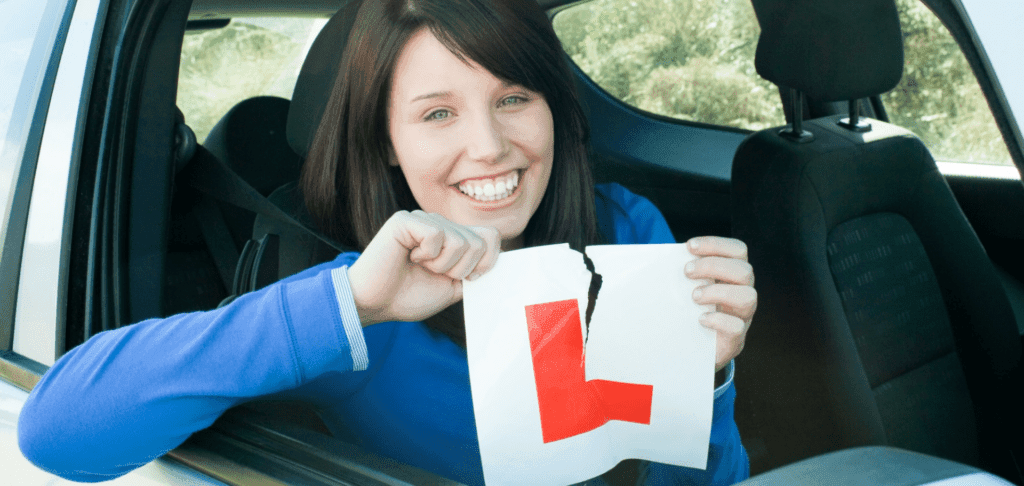
Passing your driving test feels amazing! You’ll be excited, proud, and ready for more freedom. It means you’ve learned the skills and rules to drive safely on the road. After the test, you’ll have your green driver’s licence, and new adventures will begin.
With your licence, you can now drive to work, school, or fun places with friends. But remember, being a good driver means staying responsible and following the rules. Now, enjoy the open road and make the most of your new freedom!
So, now you have passed your test, can you drive with a provisional licence? what are they things you should consider after passing your driving test? We are going to read about the next step after you pass your driving test.
Checklist now you have passed your driving test
- Applying for your pink full UK driving licence
- Buying your first car
- Car insurance
- Road tax
Can I drive straight away after passing my test?
Yes, you can drive straight away after passing your test.
It might take up to three weeks to get your new licence in the mail, but you don’t have to wait for it to drive.
You can drive as long as your car has tax and insurance.
If your new licence doesn’t come in three weeks, contact the DVLA.
If you need to change any details on your licence (like your address or photo) before getting your full licence, you must apply for it yourself.
Do this within two years of passing your test, or you’ll need to take the test again – which wouldn’t be fun.
Read more: Are driving lessons tax deductible?
Read more: Can I get free driving lessons on PIP?
The next steps after passing your driving test?
Getting your full driving licence
Now that you have passed your driving test, you do not need your provisional licence anymore. It needs to be handed back to the DVLA and replaced with your full UK driving licence.
- After you pass your driving test, the examiner will ask if you want to get your full driving licence right away. If you say yes, you will need to give them your provisional licence there and then.
- If you don’t want it automatically, you can apply for your full licence through the mail. To do this, fill out a D1 form from your local post office. Remember to apply within two years of passing your test. If you don’t apply within two years, you’ll have to take the test again, which you want to avoid!
- If you need to make changes to your licence – such as your address or photo – before having it updated, you’ll need to apply for a full licence yourself.
- If your driving licence hasn’t arrived within 3 weeks, make sure you contact the DVLA so they can help you.
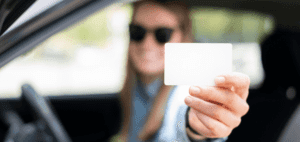
Getting car insurance
Applying for car insurance for a young driver who has just passed their driving test involves a similar process as for any other driver. Road accidents are the leading cause of death among young people which makes it costly for young drivers. Here are the steps to follow and tips for getting the best deal:
- Gather personal details, vehicle information, and driving history: This includes the young driver’s name, address, date of birth, and driving license number, as well as the make, model, and registration number of the car they’ll be driving.
- Compare quotes from multiple insurance providers: Use online comparison websites, phone calls, or visit brokers to get quotes from various insurers. Remember, not all providers are listed on comparison sites, so check with individual companies as well.
- Choose the right level of coverage: Weigh the costs and benefits of third-party only, third-party fire and theft, and comprehensive insurance policies. Be cautious about selecting the cheapest option without considering the coverage provided.
- Tips for getting the best deal for young drivers: Consider adding a more experienced driver as a named driver: Including a parent or older sibling with a good driving history on the policy may help reduce the premium.
Pay the premium annually: If financially feasible, pay the insurance premium in a single annual payment instead of monthly installments. This can save money, as many insurers charge interest on monthly payments.
Consider multi-car policies: If your household has multiple vehicles, check if your insurer offers discounts for including all cars under a single policy.
- Add a named driver: Adding a named driver to your car insurance policy can be helpful for young drivers, as it can potentially reduce their insurance premiums.
- Opt for a black box or telematics policy: These policies use a device to monitor the young driver’s driving habits, which can lead to lower premiums if they demonstrate safe driving behaviour.
- Choose a car with a smaller engine and lower insurance group: Vehicles with lower engine capacities and insurance groups are typically cheaper to insure for young drivers.
- Take an advanced driving course: Completing a Pass Plus or other advanced driving course may help lower insurance costs by demonstrating additional driving skills and competence.
- Increase the voluntary excess: A higher voluntary excess can result in a lower premium, but ensure that the young driver can afford the excess amount in case of a claim.
- Shop around for discounts and deals: Look for insurance providers offering discounts or special offers targeted at young drivers, such as student discounts or limited-mileage policies.
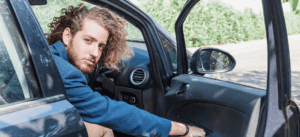
Advice – When looking for car insurance for the first time, it’s important to check the company you are looking to purchase your policy from to ensure they are not fake.’
Fake insurers, also known as “ghost brokers” or fraudulent insurance providers, are individuals or entities that claim to provide car insurance policies but are not authorised or regulated by the proper authorities.
They often target vulnerable or uninformed customers, such as young or inexperienced drivers, and may offer seemingly attractive deals on insurance policies. However, these policies are either non-existent or invalid, leaving the policyholder without proper coverage and potentially facing legal consequences.
To protect yourself from fake insurers, consider the following precautions:
- Verify the insurer’s authenticity: Check if the provider is registered with the Financial Conduct Authority (FCA) in the UK, using their online register (https://register.fca.org.uk/). You can also verify if the company is a member of the British Insurance Brokers’ Association (BIBA).
- Be cautious of unusually low premiums: If an insurance quote seems too good to be true, it often is. Compare quotes from multiple reputable providers to get a sense of the average market price.
- Avoid dealing with brokers or agents operating solely through social media or messaging apps: Legitimate insurance providers will typically have an official website, phone number and physical address.
- Check the insurer’s contact details: Make sure they have a landline phone number and a physical address. Be cautious of providers that only provide a mobile phone number or use a PO Box address.
- Be wary of high-pressure sales tactics: Fake insurers may use aggressive sales techniques to force quick decisions. Take your time and do proper research before committing to any policy.
- Request policy documents: Before making any payment, ask to see the policy documents and review them carefully. Check for any discrepancies or errors in the information provided.
- Use secure payment methods: Avoid paying in cash or through direct bank transfers. Legitimate insurers will accept secure payment methods such as credit or debit cards.
By taking these precautions and remaining vigilant, you can minimise the risk of falling victim to fake insurers and ensure that you obtain a legitimate and valid car insurance policy.
Buying your first car
When looking for your first car, there are several factors to consider to ensure you make a well-informed decision. Here are some key aspects to keep in mind:
- Budget: Determine how much you can afford to spend on your first car, taking into account the purchase price, insurance costs, vehicle tax (VED), fuel, and maintenance expenses. Be realistic about your financial constraints.
- Vehicle type: Consider your needs and preferences in terms of size, seating capacity, and cargo space. Think about whether you need a hatchback, saloon, or SUV, based on your typical driving requirements and lifestyle.
- Fuel efficiency: As a new driver, you may want to prioritise vehicles with good fuel economy to help minimise running costs. Look for cars with lower CO2 emissions, as they are generally more fuel-efficient and have lower vehicle tax rates.
- Insurance group: The insurance group of a car can significantly impact your premium costs. Opt for a car in a lower insurance group to keep your insurance costs more manageable. Smaller engine sizes and less powerful cars are usually placed in lower insurance groups.
- Reliability: Choose a make and model known for its reliability and build quality. This will help reduce the likelihood of costly repairs and improve the overall ownership experience. Research customer reviews and reliability ratings from friends and family as well as online.
- Safety features: Prioritise cars with good safety ratings and features, such as airbags, anti-lock braking systems (ABS), electronic stability control (ESC), and tyre pressure monitoring systems.
- Resale value: Some cars hold their value better than others, which can be important if you plan to sell or trade in your car in the future. Research resale values and depreciation rates for the models you’re considering.
Popular first cars in the UK known for their affordability, fuel efficiency, and lower insurance groups include the Ford Fiesta, Vauxhall Corsa, Volkswagen Polo, and Toyota Yaris. When searching for your first car, consider both new and used vehicles, and be sure to test drive any potential options to ensure they meet your needs and preferences.

How do I tax my vehicle?
As a young driver who has just passed their driving test in the UK, it’s important to understand how to tax your car. Vehicle tax, also known as road tax, is legally required for driving a car on public roads in the UK. Follow this step-by-step guide to tax your vehicle:
Gather required documents: Before you can tax your vehicle, you will need the following documents:
- A valid MOT certificate (if your car is over three years old)
- Your vehicle logbook (V5C) or the green ‘new keeper’s details’ slip (V5C/2) if you have just purchased the car
- Insurance details, as your car must be insured to be taxed
- Visit the DVLA website: Tax your car online through the DVLA site using the 16-digit reference number from your vehicle logbook (V5C) or the 12-digit reference number from the new keeper’s details slip (V5C/2).
- Choose a payment plan: You can pay for your vehicle tax annually, every six months, or monthly. There are different payment methods available, such as direct debit, credit or debit card, or through a PayPoint centre.
- Complete the transaction: Follow the instructions on the DVLA website to complete the transaction and pay for your road tax.
Once you have taxed your vehicle, you don’t need to display a paper tax disc on your windscreen, as these are no longer required. The DVLA maintains electronic records to track vehicle tax status.
Keep in mind that the amount you pay for your road tax will depend on the make and model of the car you buy. Vehicle tax bands are based on engine size or fuel type and CO2 emissions, depending on the car’s age. You might not have to pay any tax at all if your vehicle is among the most environmentally friendly. Check your vehicle’s tax band.
By following this guide, you can easily tax your car as a young driver and ensure that you stay compliant with the legal requirements for driving on public roads.
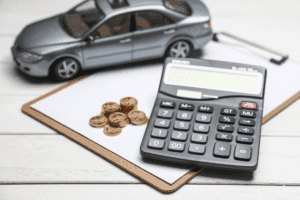
Do I need P plates after I’ve passed my test?
You don’t have to use green ‘probationary’ P plates after passing your test, but some new drivers like to use them.
P plates tell other drivers you’re new and still learning the roads. This might make them more patient with you at places like junctions and roundabouts.
You can use P plates as long as you want.
To become more confident and skilled, you can join a Pass Plus course. This course helps you get better at driving at night, on highways, and in different weather.
A bonus is that some insurance companies give lower prices to new drivers who finish the Pass Plus course.
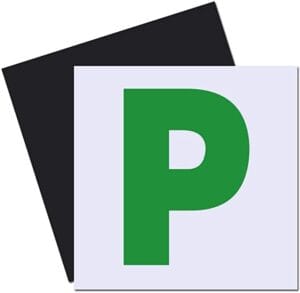
10 top tips for new drivers
- Stay calm and focused: After passing your driving test, it’s natural to feel excited and eager to hit the road. However, it’s important to stay calm and focused while driving to ensure your safety and the safety of others.
- Familiarise yourself with your car: Take time to get acquainted with your vehicle’s controls, features, and handling. Knowing your car well will help you feel more confident and comfortable on the road.
- Drive defensively: Always be aware of your surroundings and anticipate potential hazards. Keep a safe distance from other vehicles, signal your intentions well in advance, and be prepared for unexpected situations.
- Practice in different conditions: Gain experience driving in various weather conditions, at night, and in heavy traffic. This will help you become a more versatile and prepared driver.
- Avoid distractions: Keep your focus on the road by minimizing distractions such as mobile phones, loud music, and conversations with passengers. Remember that using a handheld mobile phone while driving is illegal in the UK.
- Follow speed limits and traffic rules: Abide by all traffic regulations and posted speed limits to ensure your safety and avoid penalties.
- Continue learning: Consider taking advanced driving courses, such as the Pass Plus scheme, to further improve your driving skills and potentially reduce insurance costs.
- Maintain your vehicle: Regularly check your car’s tyres, fluids, and lights to keep it in good working order and reduce the risk of breakdowns or accidents.
- Plan your route: Before setting off on a journey, plan your route and familiarise yourself with it. Use a navigation system or smartphone app if needed, but make sure it is set up before you start driving to avoid distractions.
- Build confidence gradually: Start with shorter trips on familiar roads and gradually progress to more challenging routes and longer journeys. As your confidence and experience grow, you’ll become a more competent and safer driver.
New drivers are advised not to drive straight home after passing their test due to the potential post-test adrenaline rush, which may affect their focus and driving ability.
Instead, it is recommended to take a taxi or arrange alternative transport. Additionally, your learner driver insurance may no longer be valid once the test is passed, further emphasising the importance of not driving immediately after the exam.

How to further practice after passing your driving test?
After passing your driving test, it’s essential to continue practicing and honing your skills. Here are some steps to help you further improve your driving abilities:
- Review your driving test report: Take the time to sit down with your instructor and go over the report from your driving test. Analyse any errors or areas for improvement that were identified during the test.
- Create a plan to address weaknesses: Work with your instructor to develop a plan to tackle the areas where you need improvement. This may include additional lessons or practice sessions focusing on specific skills or manoeuvres.
- Practice with an experienced driver: Spend time driving with a family member or friend who has extensive driving experience. They can provide valuable feedback and help you gain confidence on the road.
- Take additional courses: Consider enrolling in advanced driving courses, such as the Pass Plus scheme, which covers topics like motorway driving, driving in adverse weather conditions, and night driving. These courses can not only help improve your driving skills but may also lead to reduced insurance premiums.
- Drive in varied conditions: Practice driving in different weather conditions, on various road types, and at different times of the day to become more comfortable and adaptable behind the wheel.
- Set personal goals: Identify specific aspects of your driving that you want to improve and set realistic goals to achieve them. Monitor your progress over time and celebrate your accomplishments.
- Stay updated on traffic rules and regulations: Regularly review the Highway Code to ensure you remain knowledgeable about current traffic rules and regulations.
- Join a driving club or forum: Connect with other drivers through local driving clubs or online forums to share experiences, tips, and advice.
- Reflect on your driving experiences: After each drive, take a moment to reflect on what went well and what could have been better. Use this self-assessment to continuously refine your skills.
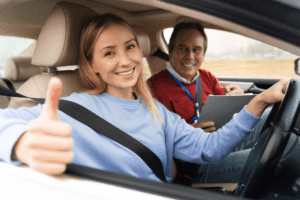
Read more: What happens after I pass my driving test?
Read more: Stopping Distances UK | Complete Guide for Beginners
Read more: How To Parallel Park For Beginners | 9 Easy Steps
Frequently asked questions
If you passed your driving test in an automatic car in the UK, you are only licenced to drive automatic vehicles.
You are not allowed to drive a manual car unless you take and pass a manual driving test. To legally drive a manual car, you will need to get a manual driving licence by taking lessons and passing a practical driving test in a manual vehicle.
No, you do not need to notify the Driver and Vehicle Standards Agency (DVSA) after passing your driving test. Once you pass your practical driving test, the examiner will handle the necessary paperwork and send your results to the DVLA (Driver and Vehicle Licensing Agency).
The DVLA will then process your application and issue your full driving licence. You should receive your full driving licence by post within three weeks of passing your test. If you haven’t received it after three weeks, you should contact the DVLA.
After passing your driving test, you will receive a pass certificate. The DVLA will then send your full driving licence to you by post, usually within three weeks. In the meantime, you can drive with your pass certificate.
Yes, you should inform your insurance company that you have passed your driving test. Your insurance policy may need to be updated, and your premiums could change now that you are a fully qualified driver.
Yes, you can start driving immediately after passing your test. As long as you have your pass certificate with you, you are legally allowed to drive while you wait for your full licence to arrive.
Once you have passed your driving test, you must remove or cover your L plates. Continuing to display them when you are no longer a learner can lead to legal issues and confusion for other drivers.
Using P plates is optional, but it is recommended for new drivers. P plates indicate to other road users that you have recently passed your test and may need extra patience and understanding as you gain experience.
Consider taking a Pass Plus course or additional driving lessons. These can help improve your skills, boost your confidence, and may even reduce your insurance premiums.
Pass Plus covers advanced driving techniques and situations not typically included in standard lessons.
Generally, there are no specific restrictions on your driving after passing the test, but it’s important to continue driving safely and responsibly.
However, if you are under 21 or have been driving for less than two years, you must be particularly careful not to accumulate six or more penalty points, as this can lead to your licence being revoked.
Yes, you can drive on motorways immediately after passing your test. If you are nervous about motorway driving, consider taking additional lessons with an instructor to build your confidence and skills in this area.
To get a Pass Plus certificate, you need to complete a Pass Plus course with an approved driving instructor.
The course consists of at least six hours of training and covers topics like motorway driving, night driving, and driving in various weather conditions. After completing the course, you will receive a certificate.
If you lose your pass certificate before your full licence arrives, contact the DVSA (Driver and Vehicle Standards Agency) as soon as possible. They will provide guidance on how to proceed and may issue a replacement certificate if necessary.



